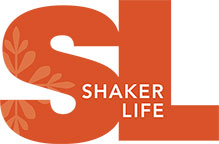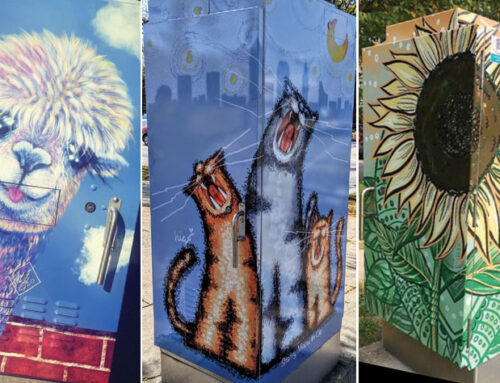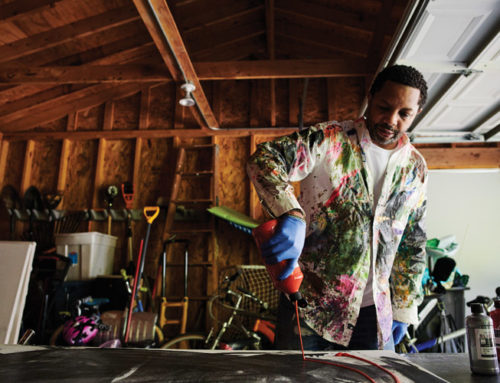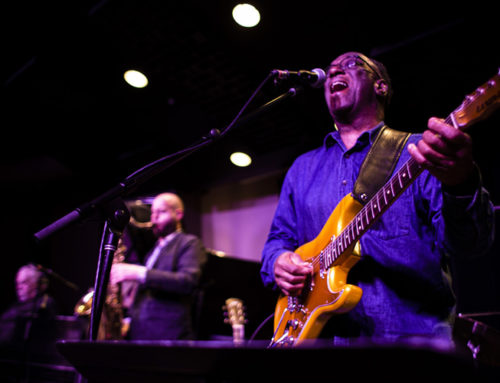A Task Force composed of six residents guides the City’s growing collection of public art. They represent a broad cross-section of expertise and experience. Here they share their visions about what public art means to a community.
By Michael Peters and Sharon Holbrook
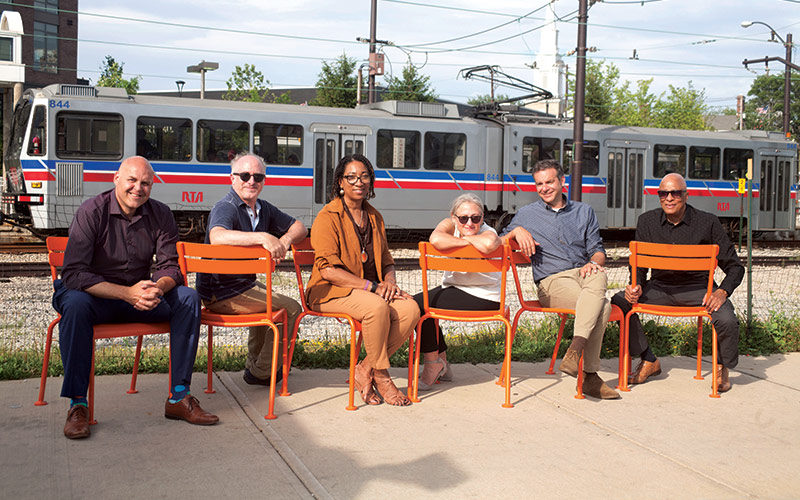
From left: Mike Obertacz, David Thal, Sandra Madison, Leslye Arian, Tom Starinsky, Ronnie Pyles
When Shaker Heights was founded in 1912, public art in Greater Cleveland was typically seen in large urban plazas and grand public spaces, not leafy residential suburbs.
“Public art, as people envision it today, is a relatively new phenomenon,” says Terry Schwarz, Director of Kent State University’s Cleveland Urban Design Collaborative (CUDC). “For a lot of cities, interest in public art has really just blossomed in the last few decades.”
Interest in adding public art to the Shaker Heights landscape was accelerated in 2017, as opportunities emerged in the Moreland neighborhood and through the planning of the Van Aken District. To ensure that the City was creating a cohesive collection that reinforced the City’s sense of identity, a Public Art Task Force was created. Under the guidance of the Planning Department, the Task Force consists of six Shaker Heights residents representing artists, architects, urban planners, and combinations of all three.
Joyce Braverman, planning director for the City says, “The Task Force represents a broad range of talented Shaker residents who bring their professional expertise in art and design to the thoughtful review of public art.”
To assist the Task Force and guide its work, the City looked to the CUDC to help develop a framework for public art in the Van Aken District (along with its existing community outreach work in the Moreland neighborhood) and to LAND Studio for project management and artist recommendations.
This led to new work – including “functional art” in the Van Aken District (seating arrangements of orange chairs), and work from Shaker Heights High School artists on utility boxes, an initiative sponsored by the Shaker Arts Council (SHAC) – adding to more than a dozen existing pieces throughout the City in Chelton and Hildana Parks, and throughout the Shaker Town Center area. Each of these pieces, while enhancing the beauty of the space, serves as a reflection on the importance of public art.
“A really important thread was making sure that the public art reflected a diverse range of perspectives: young and old, men and women, people of color, reflecting the diversity of Shaker itself,” Schwarz says. “The idea of public art as a tool for fostering social cohesion is a real and legitimate trend, as communities face new challenges and political divisions and all of the other things going on in the world. If you’re able to use art and art-making as a way of bringing people together, that provides dividends beyond beautification.”
Woven into all of these initiatives is an emphasis on community engagement and authenticity. Speaking about the community tours the CUDC led, and the surveys for the Public Art Action Strategy (PDF) that they authored, Schwarz reflected, “For such a small community, Shaker Heights has devoted a really astonishing amount of time and energy to preserving and reinforcing its image and identity. We did get a strong sense that people were looking for something fresh, to say this is new, this is Shaker, but this is a new kind of vision for what Shaker could be.”
The community engagement work and professional lens brought to these initiatives by the Task Force are critical to realizing the full potential for public art. Says Braverman, “Their work and leadership enhance our public spaces and lead to the unique Shaker identity. The many hours volunteered by this group of community leaders have a positive and long lasting impact on our community.”
MEET THE TASK FORCE
Sandra Madison • Architect
Sandra Madison’s love of art and design began as a child when she would draw, design clothing, and build dollhouses for her siblings. “I always loved to draw, I always loved to sketch,” Sandra says. “I was always creating something. I also loved beautifying my surroundings. At the time I didn’t know what an architect was.”
It was her high school guidance counselor who first introduced her to architecture, and then her mother’s network that resulted in both her first internship in Boston and later her first job in her hometown of Baltimore. Baltimore was also where she met her husband Kevin, whose father was an architect. Prior to starting a firm in Baltimore, Kevin’s father was a partner with his two brothers in the Cleveland firm that eventually became Robert P. Madison International.
“Public art is the jewelry . . . It lifts spirits, it brings people dignity.”
It was a phone call from Robert Madison, Kevin’s uncle, in 1989 that brought Sandra and Kevin to Cleveland. Today, she is Robert P. Madison International’s CEO and chair. Sandra is the designee from the City’s Architectural Board of Review to the Task Force. “I think we have a dynamic group of people, from artists to architects to stakeholders in the community who have a background in art. We all look at things in our own ways. It’s always interesting to hear comments from different perspectives.”
These perspectives are not limited to the members of the Task Force. The public is invited to participate in various aspects of the selection process, adding the neighborhood’s voice and sometimes interacting directly with the artists.
This diversity of experience is a key point, as Sandra explains. “You experience things differently all the time, including art. It might depend on who you have with you. If you have your children with you, or if you have your grandchildren with you, you might see something in it in other ways than before, because children experience it in a different way than you do. It’s wonderful to see that interaction with the artwork, with architecture, with planning.”
“Public art is the jewelry,” she says, “It lifts spirits, it brings people dignity.”
Mike Obertacz • Theater Director
You could say Mike Obertacz is a theatre person – after all, he’s the executive director of a performance art nonprofit, the Near West Theatre in the Gordon Square neighborhood of Cleveland. But it would be more accurate to say that Mike is a community person, since connection is at the heart of both his day job and his off-the-clock self. Mike, a native of Northwest Ohio, returned here from New York City six years ago. By then, he and his wife Leta had one son. (A second son arrived after their return to Ohio.)
“New York’s a phenomenal place to live when you’re a young married couple, but it’s not where I was looking to raise a family,” says Mike. “Shaker has a lot of the values that we were looking for as a family. It was important for me to live in a community with a strong school system. And I wanted a diverse community because we’re a diverse family.”
Community isn’t just at the heart of his family’s values; it also informs Mike’s work with both the Near West Theatre and the Public Art Task Force. Sure, “the play’s the thing” at Near West, but the organization’s mission goes beyond the stage. It’s a neighborhood anchor and an intergenerational organization. Near West is a place for kids to go after school and a place to learn music, drama, and technical skills, but it’s also a place where life lessons happen.
“We’re teaching kids at an early age how to be collaborative, how to create something together and be proud of that – and to be accountable for deadlines and to push beyond what they’re comfortable with,” says Mike.
A major part of Mike’s job at Near West is asking how he can best listen to the community. “I could develop any number of performing arts opportunities and experiences for our community, but they need to want it,” says Mike.
Here he sees parallels to his role on the Public Art Task Force. “I try to take that with me when I’m working on the Task Force. How are we choosing pieces of art and experiences that the community will truly value and enjoy and that will help enrich the lives of the residents of Shaker?”
“When you look at public art, the primary clients are the people who enjoy it once it’s established.”
Mike’s relationship with Shaker’s public art began in 2017 when he worked on the Shaker Heights Fire Department’s centennial mural project on Chagrin Boulevard. “When you look at public art, the primary clients are the people who enjoy it once it’s established.” That’s why he believes strongly in the kind of community feedback that the City collected on projects such as the planned art installation at the Van Aken District.
“When we ask for community feedback on projects, it is very important that we listen to that feedback. We can’t sit in a vacuum as the committee and make decisions that can impact an entire community without weighing what speaks to them as well.”
Ultimately, says Mike, it’s about telling the story of Shaker Heights and the people who live here. Again, it’s about community. “I absolutely love Shaker, and my family intends to be in Shaker for a very, very long time.”
David Thal • Architect, Photographer, Artist
“Art that is meant to make one wander, discover, investigate – that’s where my focus is. And what’s nice is that everyone brings a different focus to the group.” David Thal is explaining his role on the Public Art Task Force over the din of The Van Aken Market Hall on a recent afternoon. He would soon be off to that evening’s meeting, one of three advisory boards and selection committees on which he serves.
If a career could be made selecting public art, that likely would suit David well. An artist himself, he has experienced both being on advisory committees and submitting his work for competitions. Prior to the formation of the Public Art Task Force, he participated in the selection of the Avalon Orchard Art Fence, the Trumpet Flower on the Kenyon Walkway, and the Cloud Monoliths on Lee Road.
David’s exposure to art started at a young age. “I was taking classes at the Cleveland Museum of Art when I was just a little kid, so it started there.”
He also has a love of photography and architecture, which is his actual career. David bridges both the academic and professional worlds, sharing his passion for design, allowing each to reflect and infuse the other. He is an architect at Weber Murphy Fox where his projects have included buildings at Baldwin-Wallace, Cleveland State University, and most recently the LGBT Community Center of Greater Cleveland in the Gordon Square Arts District.
“Things that have multiple layers and meaning are the things that I’m particularly interested in.”
He is also an adjunct professor, teaching at Kent State University for over 15 years and serving as the school’s Global Education Coordinator. Despite the busy schedule, David brings a well-defined perspective to the Task Force and its work selecting artists and art works. “The voice that I bring is really to question: do we have the right amount of entries, do we have the right entries, let’s not just do it to do it. Things that have multiple layers and meaning are the things that I’m particularly interested in.”
Public input is also something David is focused on, from reading the hundreds of comments on upcoming selections to seeing how residents interact with the work once it’s completed. “What’s really great is that people are noticing public art, they’re using it, they’re reacting to it,” he says. “I’m really honored to be part of the committee.”
Ronnie Pyles • Photographer, Interior Designer
Photographer. Interior designer. Model. Traveler. Former Glenville kid. They’re all Ronnie Pyles, and he brings those varied perspectives to the Public Art Task Force.
Ronnie came to photography in a way that foretold his later advocacy for public art: on the ground, in the city. His sister, Lillian Pyles, is a casting director in Cleveland. About 20 years ago, she’d asked Ronnie to be an extra in one of her films. During a long wait for his cue, he sat in the courtyard among some old brick buildings in the Flats. “And I was wondering what the history of the buildings was, why were they built,” says Ronnie. “I sat around there for an hour or so, and decided that I wanted to do a photographic study of these buildings.”
Ronnie borrowed his father’s 35-millimeter camera, and he was hooked. The result was a series of black-and-white Cleveland photos that Ronnie had printed on blank notecards, which sold widely in shops around Cleveland. That led to sales of larger prints and to art shows, including at Juma Gallery in Shaker Heights.
“I’m just completely in love with photography,” says Ronnie.
His photography continues to focus on cityscapes and architecture, particularly those of downtown Cleveland. “That’s what I really specialize in, black-and-white photos of familiar landmark buildings like the Terminal Tower. And a lot of bridges.”
“Public art doesn’t belong to the Task Force. It belongs to the community.”
When Ronnie was a professional model, he spent time in Milan, Italy. “Something in the culture of Milan just brought out the interior designer in me. I just liked the way the Italians do design.” Ronnie has been back in Shaker Heights for about 20 years after years away. He is mostly self-taught through his intrinsic artistic sense, travel, and art and design books. Now, in addition to his photography, he works as an independent interior designer as well as a design consultant for Pottery Barn. He calls himself an eclectic, mixing different styles to create an original look.
All of this informs Ronnie’s approach to public art, but two principles in particular govern his thinking. First, he is insistent that the community have a
say in public art and that the pieces selected will draw people in. “It doesn’t belong to the Task Force. It belongs to the community.”
Second, it must appeal to kids, who gather in public places as much as anyone. “Once you get kids interested in art, they can get hooked,” Ronnie
says. “And there’s a big possibility that once you begin to like art that you’ll want to become involved in it. When you’re an adult, it’s just going to be
something that’s wonderful and you’re going to enjoy looking at it. But when you’re 10 years old, a piece of art can possibly change your life.”
Leslye Arian • Painter
One myth of the artist’s life is that it is solo and isolated – the artist as a mercurial personality toiling away in a lonely studio. But that’s definitely not Leslye Arian.
A painter of uncommon energy, Leslye has spent a lifetime in careers that marry creativity and community. After her graduation from the Cleveland Institute of Art, she worked as a designer of architectural signage, as a developer of art programming at nursing homes, and as a nonprofit administrator. At the same time, she and her husband Keith raised two children, both of whom attended Shaker Schools.
Leslye painted on her own while she was employed, but a full work schedule relegated her creative work to scattered scraps of time. After her retirement in the early 2010s, she repaid her own patience with six dedicated months of art. Then she asked her artist friends the big question: Am I ready for a show? The answer was a resounding yes, and Leslye soon had her first show at Juma Gallery.
Since then, her art has continued to take off. She’s back to her roots, represented by Bonfoey Gallery. “I’m the happiest I’ve been in my life,” she says. “It’s all really come full circle for me.”
Always energized and looking ahead, in 2015 Leslye went on to found the Shaker Community Gallery, a secular nonprofit gallery housed in Christ Episcopal Church on Warrensville Center Road in the Van Aken District. The gallery, which hosts three shows a year, was founded to showcase artists, and to support economic development in Shaker Heights by lending a creative energy and inspirational destination to the Van Aken District area.
“It’s wonderful that the City involves residents so much in the process.”
This same desire to bring people together through art led Leslye to undertake a public art installation in conjunction with the Shaker Heights Fire Department. The Fire Department wanted to commemorate its centennial in 2017 by installing public art in the pocket park adjoining the Chagrin Road station. In collaboration with the City and other artists, Leslye raised $15,000 in private donations to hire artist Augusto Bordelois to paint a mural at the park.
With this background, Leslye was a natural fit for the Public Art Task Force. “It’s wonderful that the City involves residents so much in the process,” she says, referring to the solicitation of resident feedback for the Task Force’s latest project of commissioning public art for the Van Aken District.
Leslye, keenly aware that public art is legacy, says it’s a way for a community to keep pushing towards what’s next. “Public art is not just the here-and-now. It’s something that people will grow with.”
Thomas Starinsky • Sculptor, Urban Planner
Tom Starinsky spends his days collaborating across a wide range of disciplines as the associate director of the Historic Gateway Neighborhood Corporation and Historic Warehouse District Development Corporation, neighborhoods where he has worked for the past 17 years. There he has championed varied and non-traditional approaches to public art and storytelling, most recently with a series of installations that tell the story of the neighborhood through artwork rather than a typical bronze plaque.
When he joined the Public Art Task Force, he brought this real world perspective and his experience as an artist and supporter of the arts. After receiving his undergraduate degree from the Cleveland Institute of Art in Sculpture he went on to earn his graduate degree in Urban Planning from Cleveland State University. This combination is ideal for the Task Force.
“We aspire to have a higher quality of ‘place’ through art.”
Tom is also the past president of the board of SPACES, a “public forum for artists who explore and experiment.” He led the board as it drafted its current strategic plan and moved into a new gallery space in Ohio City.
In discussing the work of the Task Force, Tom emphasizes that there is no shortage of great ideas, especially in Shaker Heights. As the City continues to evolve and respond to the needs and desires of its residents, “we aspire to have a higher quality of ‘place’ through art,” he says.
Initially those places are the Moreland neighborhood and the Van Aken District, which is not limited to the new Meade, Walker, and Tuttle streets but extends for several blocks north and south on Warrensville Center Road to include the Bloc at Almar shops and University Hospitals, west to Lomond Boulevard and the nearby shops, and past Tower East office building along Chagrin Boulevard. The process in each place was different, with residents and Lee Road businesses engaged in Moreland while the greater Van Aken District involved a cross-section of stakeholders from across the City.
The process differed because the wants and needs of the places differed. Public input “gives the neighborhoods personality,” Tom says. “I hope that
other neighborhoods join in.”
